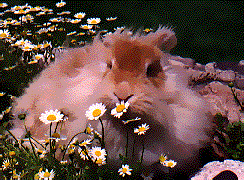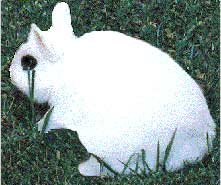
A rabbit kept as a pet is living in an unnatural environment. In order to care for our pet rabbits, we need to a keep in mind the unique needs of rabbits. They prefer a cool environment around 55 degrees Fahrenheit. In the wild, rabbits live in burrows, and they feed during the late evening and early morning when it's cool.
Outdoor pet rabbits are housed in wire or wood cages are exposed to weather extremes that can be uncomfortable or even dangerous. As responsible owners, we need to protect them from wind and rain, overheating during the summer and dehydration during all seasons from lack of water.
The ideal place to keep a pet rabbit is indoors where they can be part of the family. A clean wire cage or "bunny condo" can be made or purchased that will allow you and your bunny to enjoy each other to the fullest extent. If you house your rabbit outdoors, also keep a small indoor cage. where you can put your pet when it gets too hot outdoors. Rabbits can handle cold weather if they are sheltered properly, but heat can kill.
Rabbits are extremely hardy animals. Because they come with fur coats, it stands to reason that they are built for cooler temperatures. However, they were not built to be left in an outdoor cage with only wire to stand on in the heart of winter. The cage should be located near a fence or wall to break the wind. To protect your pet from wind and rain, install a back and sides to the cage. Throw a tarp over the cage during a severe storm.
Consider placing the cage on the back porch so you can interact with your rabbit often and easily. Keeping your rabbit in the garage is okay if the cage is on wheels so it can be brought outside on a nice day. It's very boring to live in a garage! There's nothing to see or do. Rabbits are social animals, so at least give them a view and other pets or birds to watch. If you bring your rabbit inside on a very cold day, be sure Do put them in the coolest part of the house away from any heat vents so they are not exposed to temperature extremes. If they have become accustomed to cold, a warm house could be too warm.
I provide my rabbits with wooden nest boxes year-round. They can hop up on them for exercise, chew on them to trim their teeth and get inside them for wind protection and privacy. We live in a mild area of California, and even on a most unusual 20-degree winter day, most of our bunnies were standing on top of their boxes. At the very least, rabbits should have a small wooden board to stand on. Remember, rabbits are raised outdoors in very cold climates.
If you live in an area that experiences cold winters, provide your rabbits with shelter from the wind, extra hay inside their boxes for insulation and, most importantly, adequate water. Use water crocks during winter because water bottle tubes freeze quickly and provide nothing but frustration to your rabbit.
Crocks need to be changed at least twice a day because they freeze solid within a short time. Water is essential. Rabbits will starve to death without water. They cannot eat without water. Heated crocks are available in "cold country" from the local feed stores.

Bunnies prefer a cool environment. They have no way to cool their bodies when it is hot. They have a full fur coat, and they have tiny mouths and cannot stick out their tongues to pant. The floppy eared breeds can't even use their ears to cool off. In natural circumstances, rabbits ordinarily go underground or deep in the brush on a hot day.
Because a caged rabbit is not free to choose its environment, we need to provide a cooling system in hot weather. There are many ways to do this. If you can, bring your rabbit indoors ‐ideally with air conditioning or a fan.
Outdoor cages should be located in abundant shade. A large tree or covered breezeway is best. However, keep in mind the sun does travel during the day. The ideal outdoor location during the summer may be different than the cage's winter location. I know of a rabbitry that was perfect during winter but received full sun from 2 to 5 p.m. in August. Many rabbits died on an unexpectedly hot summer day while the owner was on vacation, very sad.
The high-tech solution for a rabbitry to keep rabbits cool and safe during hot weather is the one we use at my facility, Bunny Central. Our fans run all day during the summer, and we have an automatic mister system that is controlled by a thermostat. We use large misters from Bass Equipment over our roof and small Arizona Mist misters inside. If you have one or two rabbits kept in an outdoor cage under a tree near a hose, install an Arizona Mist system (there are other brands, too) designed for cooling your patio or lounge chair. The 10-foot-long system attaches to a hose and has six small nozzles that spray a half gallon of water per hour.
If you won't be home to turn your mister system on, buy a timer at a good hardware store or garden-supply store that will turn it on and off at designated times. Pay for a good timer because it is important to regulate a mister system by time, not by gallons. The Arizona Mist system costs about $30 and the timer around $30. Position the hose so it will spray into only part of the cage, or just keep the surrounding area cool. If you give your rabbit a choice to get wet or not, it can regulate its own cooling level.

Show rabbits should not get wet because it ruins their coat. Surround them with cooling mist and use a fan. We do not have air conditioning in our home, so the rabbitry becomes a very inviting place to be during the heat of the day, as long as you don't mind getting wet. One word of caution: With too much moisture around your rabbits, there is a risk of respiratory problems. If your rabbit starts sneezing, stop using water to cool it. Instead, keep them indoors and see your veterinarian for a possible respiratory problem. Respiratory problems can kill rapidly, it is a weak link in rabbit health. That is why I strongly recommend that rabbits be raised indoors.
The poor man's version of a homemade swamp cooler consists of burlap sacks, plastic milk cartons and a fan. Tack the burlap to the edge of the cage's roof and sides. Cut one hole in the top of two or more one-gallon plastic milk carton, then cut tiny holes along the outer bottom edge of the cartons and place them on the edge of the roof. The hole in the top lets air into the carton. The water from the milk cartons drip slowly onto the burlap. This drip system takes some experimenting with to get the correct flow so practice before it gets hot. Remember, you will need more flow on a hot day because of evaporation. The fan should blow on half the cage. The resulting evaporation cools the rabbit. Mist or water and a fan can lower the temperature as much as 15 degrees. This could be the difference between life and death for your pet.
There are cooling "stands" shaped like a cobra snake with misting nozzles at the top. They connect to a hose and mist the rabbits. These are inexpensive and can provide cooling all day long with low water usage.
We all make mistakes, such as putting your rabbit in the shade and leaving for the day; forgetting that the shade moves rapidly with the sun. Or forgetting to turn on the cooling system; running out of frozen soda bottles; thoughtlessly leaving your pet in the car on a sunny day. You didn't mean it, but it happened.
If your rabbit is overheated, what should you do? Signs of an overheated rabbit are lethargy, heavy breathing, a very wet nose and muzzle, and sprawling on the floor of the cage. Cool your rabbit immediately. Get it out of the sun, run a cool water hose over its whole coat. Dunk it in a shallow bucket of water or in the sink. Be careful. Your rabbit could kick, so hold its head and protect its back. It is essential to cool your pet before its brain swells in its skull, resulting in brain damage. If your rabbit starts convulsing, it may be too late. All you can do at this point is to cool it and get it as comfortable as possible.
If your rabbit pops back after a bout of overheating, terrific. Treat it for shock; air dry it naturally (if it's still a hot day), and keep it quiet. After a trauma, a rabbit can waste away. Watch to be sure your rabbit is eating and drinking normally for the next few days. If not, a visit to the vet is in order.

In many areas of the country, hot weather comes surprisingly early. Be prepared early in the spring for hot weather. During fall, Indian summer can result in very hot days. Keep freezing soda bottles until after September is over. Coastal areas, ordinarily cool year-round, can get a rare day or two over 90 degrees. Rabbits in these areas are particularly unprepared to deal with heat. Watch those weather reports! Vacation time is also vulnerable time. Stress the importance of hot weather safety to your rabbit sitter because people unaccustomed to rabbits can be forgetful. Your rabbit will be happiest if the sitter keeps it indoors with a fan and plenty of companionship. Don't be surprised if your rabbit sitter falls in love with your rabbit and decides to get one.
I am not a veterinarian. These suggestions are from my experience with rabbits, as well as from personal research and stories I have heard. I highly suggest you get several good books from the library and learn as much as you can about rabbits -- they are unique creatures. Rabbits are a relatively new pet, so not much is known about their care. Through publications like Rabbits Annual, I try to pass along helpful information about caring for your rabbit, but my word is not gospel. Many people and organizations are attempting to fill the gaps so that our pets get the best of care. However, the responsibility for the care of your pet rests with you.

***If you linked to this page via the Bunny Central Home Page, simply close this window.***
Link to Bunny Central Home Page (for those who have not been there yet)